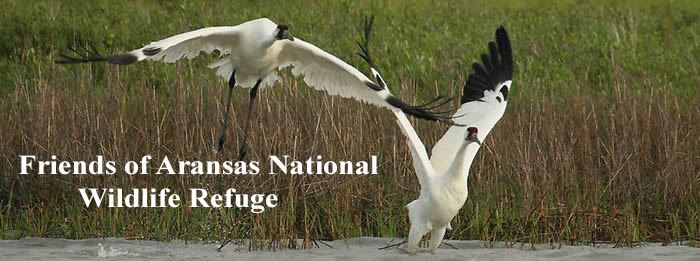Wade Harrell, U.S. Whooping Crane Recovery Coordinator
What a difference a couple weeks make! On our last update we noted a somewhat delayed migration with only a handful of whooping cranes having made their way to the Texas Coast. Now, it appears that the vast majority of the population has made their way to Texas. Most of the 25 marked whooping cranes we are tracking via GPS leg bands arrived on the wintering grounds by Nov. 14. We have recent reports and observations from all of the traditional wintering areas on and off the Refuge such as the Welder Flats area and San Jose & Matagorda Islands.
Undoubtedly, the unseasonably cool weather that much of the central plains states have experienced over the last couple weeks contributed to the movement of whooping cranes and other waterfowl to southern wintering areas. We plan to start our annual aerial whooping crane abundance survey on December 3. This coincides with the historical peak abundance of whooping cranes on the wintering grounds.
Additionally, we are already receiving reports of whooping cranes using coastal areas that lie beyond the core “traditional” wintering areas, indicative of an expanding population seeking out new habitat and resources. A few of these expansion areas that cranes have been noted this past week include the Myrtle-Foester Whitmire Unit of Aransas NWR near Indianola, TX (pair) and at The Nature Conservancy managed Mad Island Marsh Preserve near Collegeport, TX (4 adults). It is noteworthy that the whooping crane use of the Myrtle-Foester Whitmire Unit is directly across Powderhorn Lake from the recent Powderhorn Ranch conservation acquisition, highlighting the importance of acquiring and protecting habitat for the expanding whooping crane population.
We also received a photograph of a single whooper using a freshwater wetland at Padre Island National Seashore on November 18. While occasional whooping crane use at Padre Island has been documented in the historical record, it has been several years since an observation has been noted there.
Whooping Cranes on the Refuge
Whooping Cranes are now being regularly observed from both the Heron Flats observation deck and the Refuge observation tower, so bring your binoculars and come on out to get a first-hand look at North America’s tallest birds along with a wide variety of other wildlife species!.
New Facebook Page for Aransas National Wildlife Refuge!
Aransas National Wildlife Refuge now has an official Facebook page! We’ll be posting updates about whooping cranes and other wildlife observations, management activities, and refuge happenings. “Like” us for timely information!
Texas Whooper Watch
Texas Whooper Watch has done a great job in getting the word out on whooping crane migration to the public this year. Take some time to check out their website.
The public provided several reports of whooping crane migration this season, including a great photo of 8 adult whooping cranes migrating south through Milam County on November 9th. We owe a big thanks to Katherine Bedrich for the report and photo! This type of information helps confirm migration routes, timing and behavior so we better understand what whooping cranes need to continue increasing their numbers.
Be sure to report any Texas sightings beyond the known Aransas/Lamar area via email: whoopingcranes@tpwd.state.tx.us or phone: (512) 389-TXWW (8999).
Food & Water Abundance
The photo below taken by a Refuge remote trail camera shows a pair of whooping cranes departing from a recently rehabilitated well site (converted from windmill to solar pump) that provides freshwater to cranes and other wildlife species on the Blackjack Unit of Aransas NWR:For more information on the Refuge’s “Water for Wildlife” initiative, see our last whooping crane update.

Precipitation/Salinity
As we have stated before, weather conditions play a significant role in whooping crane behavior, including migration timing and habitat selection. Weather conditions may also change our Refuge management strategies for whooping cranes, such as providing freshwater from wells during times of drought. If you enjoy tracking local weather conditions, you might check out the South Texas Weather Journal provided by our partners at the National Weather Service. This edition discusses several local weather patterns that have the potential to impact whooping cranes here on the wintering grounds including timing of hurricanes, drought forecasts and tidal changes in local bays.
